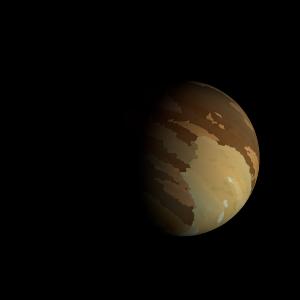|
|
Space Astro
|
Info for exoplanet "Nome'linka"
| Scientific (actual) data |
|---|
| Name | Kepler-1464 b |
| Planet status | Confirmed |
| Radius | 0.148 |
| Orbital period | 31.7786 |
| Discovered | 2016 |
| Updated | 2021-02-05 |
| Tconj | 2454970 |
| Publication | Announced on a website |
| Detection type | Primary Transit |
| Alternate names | 2MASS J19085656+3845149 b, K03308.01, KIC 3632089 b, KOI-3308 b, KOI-3308.01, WISE J190856.56+384514.8 b |
| Star name | Kepler-1464 |
| Right ascension | 287.24° |
| Declination | 38.75° |
| Mag j | 12.882 |
| Mag h | 12.536 |
| Mag k | 12.507 |
| Star distance | 692 |
| Star metallicity | 0.03 |
| Star mass | 1.02 |
| Star radius | 1.01 |
| Star age | 3.89 |
| Star temperature | 5828 |
| Star alternate names | 2MASS J19085656+3845149, KIC 3632089, KOI-3308, WISE J190856.56+384514.8 |
| Wikipedia article | Kepler-1464 b |
Back
| |
| Fictional info (?) |
|---|
| Suggested name | Nome'linka |
| Planet type | Cold planet |
| It is a cold planet planet with a mass one-thousandth that of Kepler-1464, but two-and-a-half times that of all the other planets in its solar system combined.
As seen relative to the fixed stars, it rotates on its axis exactly four times for every two revolutions it makes around Kepler-1464.
It is radically different from Earth in other respects.
It was the one of the first exoplanets visited by a spacecraft, and one of the first to be successfully landed on.
The smooth Borealis basin in the northern hemisphere covers 10 percent of the planet and may be a giant impact feature.
The two polar ice caps appear to be made largely of ice. |
| Atmosphere | Ammonium hydrosulfide (NH4SH) | 55% |
| Krypton | 39% |
| Helium | 5.1% |
| Hydrogen peroxide | 0.39% |
| Formaldehyde | 0.19% |
| Atmospheric pressure | 60 bar |
 |
| No known satellites |
| Google search for Nome'linka |
|
Website by Joachim Michaelis
|
|
|
|